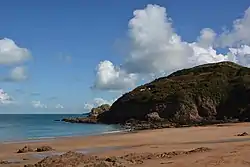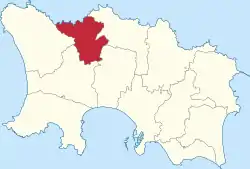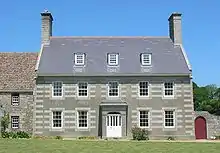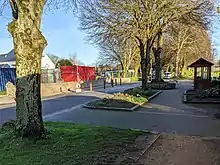Saint Mary, Jersey
Saint Mary (Jèrriais: Sainte Mathie) is one of the twelve parishes of Jersey, Channel Islands. It is 7.7 kilometres (4.8 mi) north-west of St Helier.[lower-alpha 1] It is the smallest parish by surface area, with an area of 3,604 vergées (6.5 km2).
Saint Mary
| |
|---|---|
 Grève de Lecq in St Mary | |
.svg.png.webp) Coat of arms | |
 Location of Saint Mary in Jersey | |
| Crown Dependency | Jersey, Channel Islands |
| Government | |
| • Type | Parish |
| • Connétable | John Le Bailly |
| • Deputy | David Johnson |
| Area | |
| • Total | 6.5 km2 (2.5 sq mi) |
| Area rank | Ranked 11th |
| Population (2011) | |
| • Total | 1,752 |
| • Density | 270/km2 (700/sq mi) |
| Time zone | GMT |
| • Summer (DST) | UTC+01 |
| Postcode district | |
| Postcode sector | 3 |
The parish is rural, with a low population of only 1,752 in 2011, with a single sparse village. It borders four other parishes: Saint Ouen, Saint John, Saint Peter and Saint Lawrence.
History
The Jersey parish system has been in place for centuries. By Norman times, the parish boundaries were firmly fixed and remain largely unchanged since.[2]
The parish and its eponymous church derive their name from a medieval monastery, probably destroyed during Viking raids some time between the 8th and 10th centuries. In 1042 Duke William gave "Saint Mary of the Burnt Monastery" to the abbey of Cerisy.
In 1180 Jersey was divided by the Normans into three ministeria for administrative purposes. St Mary was part of Crapoudoit. Crapoudoit likely refers to the stream running through St Peter's Valley.[2]
Governance
The parish is divided into vingtaines for administrative purposes as follows:
The boundary between the vigntaines run from the parish boundary with St Ouen and along the north side of La Rue Mahier. The boundary then runs along the north side of some of the buildings north of La Verte Rue. It then runs in a direct line from the southern end of La Rue du Motier to the southern end of La Rue de la Grosse Épine directly to its junction with Rue d'Olive. From there it runs to the border with St John.
The parish forms one electoral district and elects one Deputy.
Geography

Mourier Valley runs down the boundary between Saint Mary and Saint John. The stream formerly powered a number of mills despite the scant population of the area.
La Grève de Lecq is the main bay in the parish and lies on the border with St Ouen. It can be accessed from the village down a valley known as Le Mont de Ste Marie.
The parish stands upon coarse-grained granite, 'of Saint Mary's type', which formed during the lower Palaeozoic period. This granite was formerly quarried for building.[3]
St Mary's Village

St Mary's Village is the main settlement in the village. It is formed around a box of sorts of main roads with link roads in between. The village's amenities are formed roughly in three clumps: the parish hall, rec centre and primary school; the parish church, cemetery and pub; and the petrol station. There is also a Methodist church.
The village has a blanket 20 mph speed limit, introduced in 2015.[4] Previously, there had been a 30 mph limit on the southern main road and a 20 mph on the northern main road. The village has extensive traffic calming, including raised junctions, filtered permeability, virtual footpaths and build-outs. The village won the Chartered Institution of Highways and Transportation award for traffic calming measures introduced in the parish in the 2010s.[5]
Demographics
St. Mary has the smallest population of all the parishes in Jersey, having only 1,591 residents in 2001.
| Year | Pop. | ±% |
|---|---|---|
| 1991 | 1,449 | — |
| 1996 | 1,475 | +1.8% |
| 2001 | 1,591 | +7.9% |
| 2011 | 1,752 | +10.1% |
Landmarks
.JPG.webp)
Among the natural attractions of the parish is a feature known as the Devil's Hole[6] (Lé Creux du Vis), a blowhole in the cliffs of the coast. The descent from the car park to the Devil's Hole is a popular tourist attraction, with the walk taking approximately ten minutes. The upper part of the path is surfaced, and the lower part, once quite dangerous in parts, now has wooden steps and handrails, with much of the access having been improved by a working party from the Royal Engineers Corps of the British Army. In Victorian times it was possible to descend into the hole itself at low tide, but this is no longer possible. However, the access path ends at a large specially constructed viewing platform. Following a shipwreck in 1851, when the ship's figurehead washed up in the Devil's Hole, a statue of a devil adapted from the figurehead was set up above the Hole.[7] This wooden statue was replaced by a succession of modern versions in the 20th century.
On the east side of the bay, in Saint Mary, lies Le Castel de Lecq, a mediaeval earthwork. In the bay Le Moulin de Lecq, an old watermill, was converted into a residence in 1929 and following the Second World War became a pub, while retaining the wheel and remnants of the gears.
Crabbé is the location for pistol shooting.
Twinned places
Saint Mary is twinned with Longues-sur-Mer, a commune of the département of Calvados, in the Normandy région of France.
Notes
- Measured from the Church to the Royal Square
References
- "Election results 2018". Gov.je. Retrieved 2020-03-31.
- Syvret, Marguerite (2011). Balleine's History of Jersey. The History Press. ISBN 978-1860776502.
- Institute of Geological Sciences, Jersey. (Channel Islands Sheet 2) 'Solid and Drift', by D.H. Keen and A.C. Bishop. Published 1982, G.M. Brown, Director, Institute of Geological Sciences.
- "Road Traffic (Speed Limits) (Jersey) Order 2003". www.jerseylaw.je. Retrieved 2021-01-17.
- Express, Bailiwick. "St Mary's controversial traffic calming measures win national award". Bailiwick Express. Retrieved 2021-01-17.
- "National Trust - Devil's Hole". Nationaltrustjersey.org.je. Archived from the original on 2012-02-07. Retrieved 2012-10-05.
- "Turnkey" Giffard and the Devil Archived August 8, 2007, at the Wayback Machine
See Also
- Historic Jersey, W.S. Ashworth, Jersey 1993 (no ISBN)